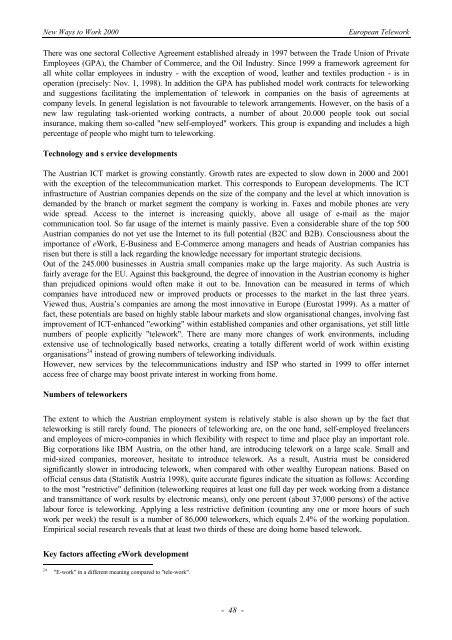eWORK 2000 - European Telework Week
eWORK 2000 - European Telework Week
eWORK 2000 - European Telework Week
- No tags were found...
You also want an ePaper? Increase the reach of your titles
YUMPU automatically turns print PDFs into web optimized ePapers that Google loves.
New Ways to Work <strong>2000</strong><strong>European</strong> <strong>Telework</strong>There was one sectoral Collective Agreement established already in 1997 between the Trade Union of PrivateEmployees (GPA), the Chamber of Commerce, and the Oil Industry. Since 1999 a framework agreement forall white collar employees in industry - with the exception of wood, leather and textiles production - is inoperation (precisely: Nov. 1, 1998). In addition the GPA has published model work contracts for teleworkingand suggestions facilitating the implementation of telework in companies on the basis of agreements atcompany levels. In general legislation is not favourable to telework arrangements. However, on the basis of anew law regulating task-oriented working contracts, a number of about 20.000 people took out socialinsurance, making them so-called "new self-employed" workers. This group is expanding and includes a highpercentage of people who might turn to teleworking.Technology and s ervice developmentsThe Austrian ICT market is growing constantly. Growth rates are expected to slow down in <strong>2000</strong> and 2001with the exception of the telecommunication market. This corresponds to <strong>European</strong> developments. The ICTinfrastructure of Austrian companies depends on the size of the company and the level at which innovation isdemanded by the branch or market segment the company is working in. Faxes and mobile phones are verywide spread. Access to the internet is increasing quickly, above all usage of e-mail as the majorcommunication tool. So far usage of the internet is mainly passive. Even a considerable share of the top 500Austrian companies do not yet use the Internet to its full potential (B2C and B2B). Consciousness about theimportance of eWork, E-Business and E-Commerce among managers and heads of Austrian companies hasrisen but there is still a lack regarding the knowledge necessary for important strategic decisions.Out of the 245.000 businesses in Austria small companies make up the large majority. As such Austria isfairly average for the EU. Against this background, the degree of innovation in the Austrian economy is higherthan prejudiced opinions would often make it out to be. Innovation can be measured in terms of whichcompanies have introduced new or improved products or processes to the market in the last three years.Viewed thus, Austria’s companies are among the most innovative in Europe (Eurostat 1999). As a matter offact, these potentials are based on highly stable labour markets and slow organisational changes, involving fastimprovement of ICT-enhanced "eworking" within established companies and other organisations, yet still littlenumbers of people explicitly "telework". There are many more changes of work environments, includingextensive use of technologically based networks, creating a totally different world of work within existingorganisations 24 instead of growing numbers of teleworking individuals.However, new services by the telecommunications industry and ISP who started in 1999 to offer internetaccess free of charge may boost private interest in working from home.Numbers of teleworkersThe extent to which the Austrian employment system is relatively stable is also shown up by the fact thatteleworking is still rarely found. The pioneers of teleworking are, on the one hand, self-employed freelancersand employees of micro-companies in which flexibility with respect to time and place play an important role.Big corporations like IBM Austria, on the other hand, are introducing telework on a large scale. Small andmid-sized companies, moreover, hesitate to introduce telework. As a result, Austria must be consideredsignificantly slower in introducing telework, when compared with other wealthy <strong>European</strong> nations. Based onofficial census data (Statistik Austria 1998), quite accurate figures indicate the situation as follows: Accordingto the most "restrictive" definition (teleworking requires at least one full day per week working from a distanceand transmittance of work results by electronic means), only one percent (about 37,000 persons) of the activelabour force is teleworking. Applying a less restrictive definition (counting any one or more hours of suchwork per week) the result is a number of 86,000 teleworkers, which equals 2.4% of the working population.Empirical social research reveals that at least two thirds of these are doing home based telework.Key factors affecting eWork development24"E-work" in a different meaning compared to "tele-work".- 48 -








